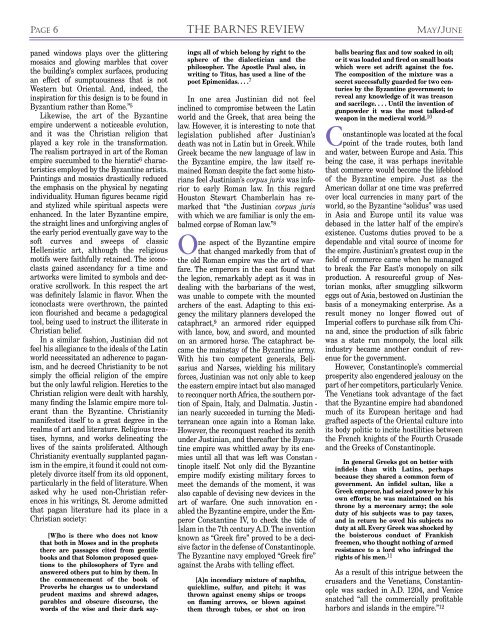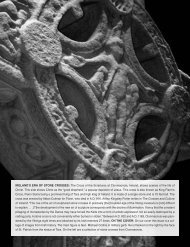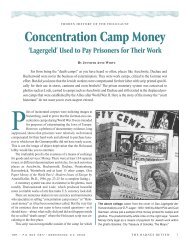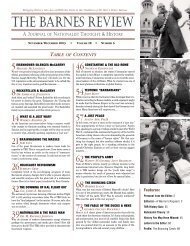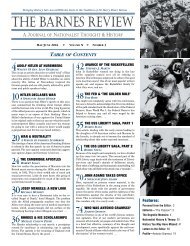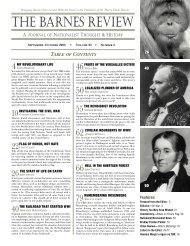Create successful ePaper yourself
Turn your PDF publications into a flip-book with our unique Google optimized e-Paper software.
PAGE 6 the barnes review MAY/JUNE<br />
paned windows plays over the glittering<br />
mosaics and glowing marbles that cover<br />
the building’s complex surfaces, producing<br />
an effect of sumptuousness that is not<br />
Western but Oriental. And, indeed, the<br />
inspiration for this design is to be found in<br />
Byzantium rather than Rome.” 5<br />
Likewise, the art of the Byzantine<br />
empire underwent a noticeable evolution,<br />
and it was the Christian religion that<br />
played a key role in the transformation.<br />
<strong>The</strong> realism portrayed in art of the Roman<br />
empire succumbed to the hieratic 6 characteristics<br />
employed by the Byzantine artists.<br />
Paintings and mosaics drastically reduced<br />
the emphasis on the physical by negating<br />
individuality. Human figures became rigid<br />
and stylized while spiritual aspects were<br />
enhanced. In the later Byzantine empire,<br />
the straight lines and unforgiving angles of<br />
the early period eventually gave way to the<br />
soft curves and sweeps of classic<br />
Hellenistic art, although the religious<br />
motifs were faithfully re tained. <strong>The</strong> iconoclasts<br />
gained ascendancy for a time and<br />
artworks were limited to sym bols and decorative<br />
scrollwork. In this respect the art<br />
was definitely Islamic in flavor. When the<br />
iconoclasts were overthrown, the painted<br />
icon flourished and became a pedagogical<br />
tool, being used to instruct the illiterate in<br />
Christian belief.<br />
In a similar fashion, Justinian did not<br />
feel his allegiance to the ideals of the Latin<br />
world necessitated an adherence to paganism,<br />
and he decreed Christianity to be not<br />
simply the official religion of the empire<br />
but the only lawful religion. Heretics to the<br />
Christian religion were dealt with harshly,<br />
many finding the Islamic empire more tolerant<br />
than the Byzantine. Christianity<br />
manifested itself to a great degree in the<br />
realms of art and literature. Religious treatises,<br />
hymns, and works delineating the<br />
lives of the saints proliferated. Although<br />
Christianity eventually supplanted paganism<br />
in the empire, it found it could not completely<br />
divorce itself from its old opponent,<br />
particularly in the field of literature. When<br />
asked why he used non-Christian references<br />
in his writings, St. Jerome admitted<br />
that pagan literature had its place in a<br />
Chris tian society:<br />
[W]ho is there who does not know<br />
that both in Moses and in the prophets<br />
there are passages cited from gentile<br />
books and that Solomon proposed questions<br />
to the philosophers of Tyre and<br />
answered others put to him by them. In<br />
the commencement of the book of<br />
Proverbs he charges us to understand<br />
prudent maxims and shrewd adages,<br />
parables and obscure discourse, the<br />
words of the wise and their dark say-<br />
ings; all of which belong by right to the<br />
sphere of the dialectician and the<br />
philosopher. <strong>The</strong> Apostle Paul also, in<br />
writing to Titus, has used a line of the<br />
poet Epimenidas. ... 7<br />
In one area Justinian did not feel<br />
inclined to compromise between the Latin<br />
world and the Greek, that area being the<br />
law. However, it is interesting to note that<br />
legislation published after Justinian’s<br />
death was not in Latin but in Greek. While<br />
Greek became the new language of law in<br />
the Byzantine empire, the law itself re -<br />
mained Roman despite the fact some historians<br />
feel Justinian’s corpus juris was inferior<br />
to early Roman law. In this regard<br />
Houston Stewart Chamberlain has re -<br />
marked that “the Justinian corpus juris<br />
with which we are familiar is only the em -<br />
balmed corpse of Roman law.” 8<br />
One aspect of the Byzantine empire<br />
that changed markedly from that of<br />
the old Roman empire was the art of warfare.<br />
<strong>The</strong> emperors in the east found that<br />
the legion, remarkably adept as it was in<br />
dealing with the barbarians of the west,<br />
was unable to compete with the mounted<br />
archers of the east. Adapting to this exigency<br />
the military planners developed the<br />
cataphract, 9 an armored rider equipped<br />
with lance, bow, and sword, and mounted<br />
on an armored horse. <strong>The</strong> cataphract be -<br />
came the mainstay of the Byzantine army.<br />
With his two competent generals, Beli -<br />
sarius and Nar ses, wielding his military<br />
forces, Justinian was not only able to keep<br />
the eastern empire intact but also managed<br />
to reconquer north Africa, the southern portion<br />
of Spain, Italy, and Dalmatia. Jus tin -<br />
ian nearly succeeded in turning the Medi -<br />
terranean once again into a Roman lake.<br />
However, the reconquest reached its ze nith<br />
under Jus tinian, and thereafter the By zan -<br />
tine empire was whittled away by its enemies<br />
until all that was left was Con stan -<br />
tinople itself. Not only did the Byzan tine<br />
em pire modify existing military forces to<br />
meet the demands of the moment, it was<br />
also capable of devising new devices in the<br />
art of war fare. One such innovation en -<br />
abled the Byzantine empire, under the Em -<br />
per or Constantine IV, to check the tide of<br />
Islam in the 7th century A.D. <strong>The</strong> invention<br />
known as “Greek fire” proved to be a decisive<br />
factor in the defense of Constan tin ople.<br />
<strong>The</strong> Byzantine navy employed “Greek fire”<br />
against the Arabs with telling effect.<br />
[A]n incendiary mixture of naphtha,<br />
quicklime, sulfur, and pitch; it was<br />
thrown against enemy ships or troops<br />
on flaming arrows, or blown against<br />
them through tubes, or shot on iron<br />
balls bearing flax and tow soaked in oil;<br />
or it was loaded and fired on small boats<br />
which were set adrift against the foe.<br />
<strong>The</strong> composition of the mixture was a<br />
secret successfully guarded for two centuries<br />
by the Byzantine government; to<br />
reveal any knowledge of it was treason<br />
and sacrilege. ... Until the invention of<br />
gunpowder it was the most talked-of<br />
weapon in the medieval world. 10<br />
Constantinople was located at the focal<br />
point of the trade routes, both land<br />
and water, between Europe and Asia. This<br />
being the case, it was perhaps inevitable<br />
that commerce would become the lifeblood<br />
of the Byzantine empire. Just as the<br />
American dollar at one time was preferred<br />
over local currencies in many part of the<br />
world, so the Byzantine “solidus” was used<br />
in Asia and Europe until its value was<br />
debased in the latter half of the empire’s<br />
existence. Customs duties proved to be a<br />
dependable and vital source of income for<br />
the empire. Justinian’s greatest coup in the<br />
field of commerce came when he managed<br />
to break the Far East’s monopoly on silk<br />
production. A resourceful group of Nes -<br />
torian monks, after smuggling silkworm<br />
eggs out of Asia, bestowed on Justinian the<br />
basis of a moneymaking enterprise. As a<br />
result money no longer flowed out of<br />
Imperial coffers to purchase silk from Chi -<br />
na and, since the production of silk fabric<br />
was a state run monopoly, the local silk<br />
industry became another conduit of revenue<br />
for the government.<br />
However, Constantinople’s commercial<br />
prosperity also engendered jealousy on the<br />
part of her competitors, particularly Ven ice.<br />
<strong>The</strong> Venetians took advantage of the fact<br />
that the Byzantine empire had abandoned<br />
much of its European heritage and had<br />
grafted aspects of the Oriental culture into<br />
its body politic to incite hostilities between<br />
the French knights of the Fourth Crusade<br />
and the Greeks of Constantinople.<br />
In general Greeks got on better with<br />
infidels than with Latins, perhaps<br />
because they shared a common form of<br />
government. An infidel sultan, like a<br />
Greek emperor, had seized power by his<br />
own efforts; he was maintained on his<br />
throne by a mercenary army; the sole<br />
duty of his subjects was to pay taxes,<br />
and in return he owed his subjects no<br />
duty at all. Every Greek was shocked by<br />
the boisterous conduct of Frankish<br />
freemen, who thought nothing of armed<br />
resistance to a lord who infringed the<br />
rights of his men. 11<br />
As a result of this intrigue between the<br />
crusaders and the Venetians, Constantin -<br />
ople was sacked in A.D. 1204, and Venice<br />
snatched “all the commercially profitable<br />
harbors and islands in the empire.” 12


